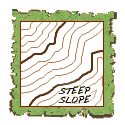Products You May Like
Get access to everything we publish when you
sign up for Outside+.
When was the last time you planned a backpacking trip without a computer, phone, or GPS unit? Think hard. Unless you’re a dedicated old-schooler, it probably wasn’t recently.
If your map skills are rusty, it’s time to brush up. Maps and compasses are the best backups to your navigation system (no battery or cell service required), and will give you an understanding of the ground you’re hiking on that you just can’t get following a gadget. More importantly: Doing it the way hikers did it 50 years ago gives you more trail cred.
Topographic maps are ideal for backpackers. They’re different from other maps because they outline the three-dimensional landscape: its contours, elevations, topographic features, bodies of water, vegetation, and more.
Why Do I Need a Topo Map?
Simplified trail maps—such as the JPEG images you might find on a national park’s website—don’t always include all the information you need for complete navigation. There’s no elevation data, no magnetic declination, and not as many symbols. If you get lost, these trail maps won’t help you find your way out. A topographic map offers a wealth of orienteering information, too. It not only shows elevation and distance, but also human-made structures and changes in vegetation. There’s enough information on a topo map to plan an entire trip in advance and also find your bearings in a pinch.
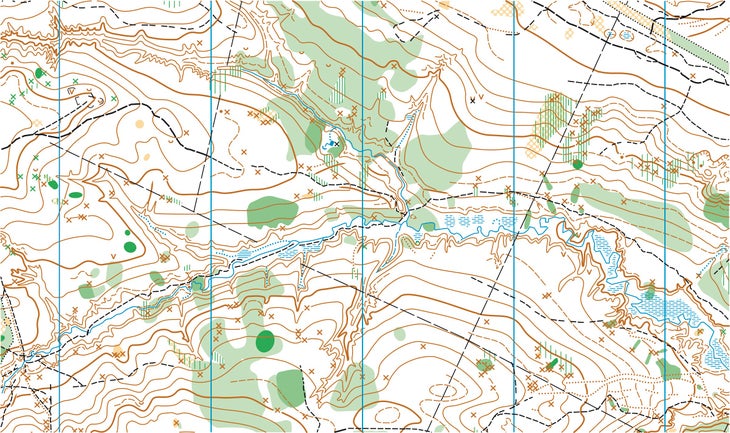
Anatomy of a Topo Map
Contour Lines
The thin brown lines snaking around a topographic map are contour lines. All points along the same contour line are at the same elevation above sea level. Think of a contour line as a closed loop: By following a contour line on the ground, you would travel neither uphill nor downhill, eventually ending up back at your starting point. When you hike, you’re passing through the contour lines, not staying along one as if it were a trail. Check your map’s legend for the contour interval, which tells you how many vertical feet apart they are from one another (usually 40 feet).
Contour lines allow you to infer general terrain characteristics from their patterns. Here’s what you can expect to see on a topographic map:
A. Steep terrain
Crowded sections of contour lines
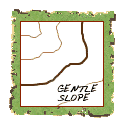
B. Gradual terrain
Spacious sections of contour lines
C. Trail
Black, dashed line
D. Switchbacks
Zigzagging trail
E. Ridge
V-shaped contour lines that “point” to lower elevations
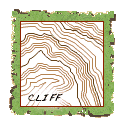
F. Cliff
Super concentrated lines
G. Dirt road
Black, dashed double-line
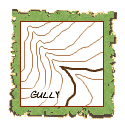
H. Gully
V-shaped contour lines that“point” toward higher elevations
I. Railroad tracks
Solid black line with hatch marks
J. Stream
Solid blue line
K. Waterfall
Single blue hatch intersecting a stream
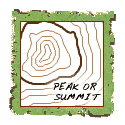
L. Summit
Contour line forms a small circle

Contour Lines vs. Reality
As reliable as a topographic map might be, it can’t reveal every detail of the terrain. A 20-foot-high cliff or a 30-foot deep ditch could exist between two 40-foot contour lines, and you wouldn’t know it because it won’t be indicated on the map in any way. Because contour lines are measured in regular intervals, you can find a wide elevation variation in the terrain between two contour lines.
A route that climbs up a gentle creek to the ridgetop might look ideal on the map only to be an impassable tangle of downed trees left by a winter storm when you try to hike it. Flexibility, then, is the key navigation with any map.
Index and Interval Lines
You’ll notice both thin and thick contour lines on a topo map, and every fifth line is thicker than the others. Those thick contour lines are called index lines. At some point along an index line, you can see a label revealing the elevation. A line marked “6500,” for example, means that point on the map is 6,500 feet above sea level.
The thinner, unmarked contour lines between the index lines are called interval lines. Use the elevation marked on index lines to calculate the elevation of interval lines. On a map with a 40-foot contour interval, the interval line to the inside of the index line would be at 6,540 feet above sea level. The interval line to the outside of the index line would indicate 6,460 feet above sea level.

Colors on a Topo Map
Red: Overprinted on significant primary and secondary roads. Also used to denote surveying features that belong to the U.S. Public Land Survey.
Black: Manmade or cultural features.
Blue: Water-related features.
Brown: Contour lines and elevation numbers.
Green: Vegetation features. Generally, darker colors mean denser vegetation, and lighter areas indicate thin vegetation or even open terrain.
White: Sparse or no vegetation. Basically, it indicates any landscape feature except for trees or water, including desert, grass, sand, rocks, boulders, and so on.
Purple: Revisions that have been made to a map using aerial photos. The USGS no longer does this, but existing maps might have purple revisions.
Topo Map Scale Compared to Reality
Scale is the relative distance of the map to real life. The scale is in the map legend and usually shows the ratio of map inches to real ground inches. For example, a scale of 1:25,000 means that 1 inch on the map is the equivalent of 25,000 inches—or just under 0.4 miles—in reality. (This is the scale used by most USGS topo maps.) The first number, map inches, is always 1.
Scale tells you how detailed the map is. A topo map with a scale of 1:10,000 shows a smaller area and is more detailed than a map with a 1:25,000 scale because it is more zoomed in. It’s important to know how detailed your map is when you’re planning a route. A map with a scale between 1:50,000 and 1:100,00 shows less detail but can help you understand the general landscape, watershed, and trail network of the region you’re in.
Maps also include a representative scale, which helps visualize distances in miles or kilometers, and is much more useful than measuring your dayhike or thru-hike inch by inch. Use a piece of string or a ruled compass edge to measure your route on the map with the representative scale.
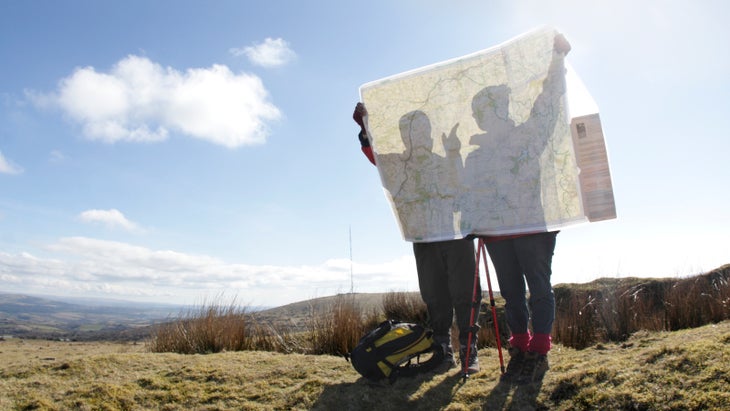
Reading the Legend
The legend is in the corner of the page and defines the different symbols throughout the map. Here’s what you can find:
Source data: Where and when the map was made. Be sure to check that the map isn’t out of date, and try to get the most recent version possible.
Scale: Relative distance on the map compared to distance in real life.
Contour interval: Change in elevation between each contour line. These line intervals usually indicate 40 feet of elevation change and will show exactly how steep that section on the trail will be.
Magnetic declination: True north is different from magnetic north, which is what your compass follows. The difference between magnetic north and true north in the given area is the declination. This varies from place to place, and it’s necessary to set up your compass before you start hiking. If you don’t adjust for declination, you can be steering yourself off course by hundreds of miles.
A color key: Different colors across the map often show the nature of the vegetation. Generally, darker colors mean denser vegetation, while lighter areas mean thin vegetation or even open terrain. Bodies of water are usually blue.
A symbol key: Most topo maps use symbols to indicate certain features. The key can also explain what different stylized lines mean, like the ones that indicate boundaries, rivers and streams, pipelines, roads, or railroads.
Some other symbols you can find in a topo map that will be defined in a legend include: water tanks, buildings, open pits, caves, waterfalls, glaciers, marine shorelines, and more.
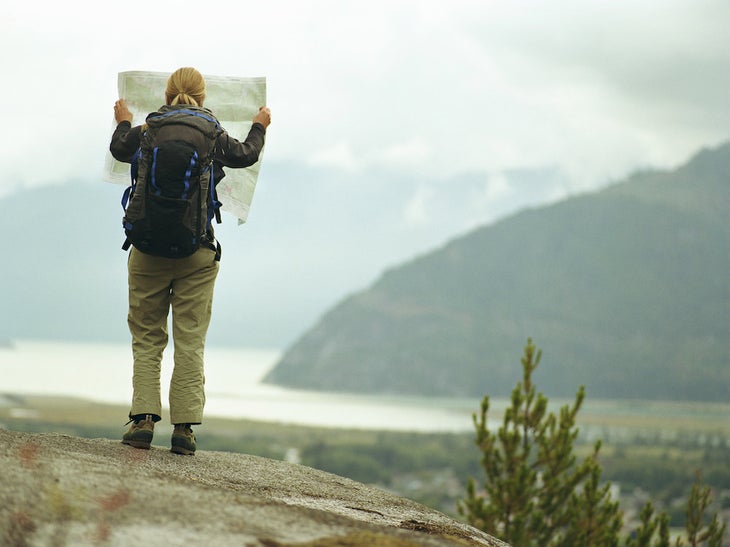
Preparing for a Trip with a Topo Map
A topographic map is a vital tool for planning any backpackingtrip. It will help you plan a route, know what’s ahead of you, and be prepared.
Trails usually appear as thin black lines, while roads are thicker black or red lines. (The key should help you distinguish between them.) As you plan your route, keep an eye on the contour lines. You don’t want to plan a route that takes you over a cliff you can’t climb or across a ridgeline you didn’t prepare for. Generally, you’ll also want to have an idea of how steep the hike will be. Find ways around any landmarks you don’t want to traverse and identify the best routes to ascend any peaks.
Once you’ve picked out a route, use the scale to measure its distance. Using a string rather than a straight edge will give you a much more accurate distance estimate, as it will include the twists and turns in the trail. You don’t want to measure a series of switchbacks as one straight line.
Use the map’s symbols to identify water sources, dangerous areas to avoid (like mine shafts), and changes in vegetation. This information will also help you pick out the best campsites and minimize safety risks.
Practice Makes Perfect
The more you practice reading the topo map, the less likely you are to get lost. Keep your map within reach as you hike and follow your trajectory. Make note of landmarks that you pass and take stock of where you are regularly.
Use smartphones and GPS as a tool to learn rather than relying on them. As you get used to orienteering with a topo and compass, check your calculations against a mapping app like Gaia GPS (available free to Outside+ members) on your smartphone. Does your supposed location on the topo match the location indicated on your phone? As you practice orienteering, your calculations should get more accurate. You should never rely solely on GPS technologies to navigate without a backup plan.
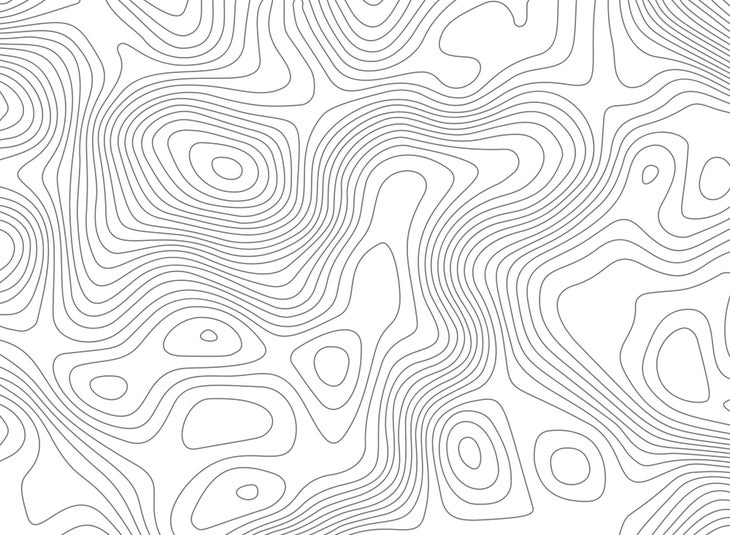
Where to Get a Topo Map
You can find topographic maps from many different sources. The one you choose depends on the place you’re hiking and whether you want to emphasize specific information.
USGS
You can download maps from the USGS and print them out free of charge in various formats. These are updated every three years.
Local government agencies
Many national parks, national forests, state parks, and other public lands produce detailed maps of their lands. Check their website or local offices to see if they have topographic maps available.
Specialty companies
These companies often produce maps for more popular areas. Sometimes they highlight hiker-specific features like backcountry campsites, park boundary lines, or certain trails and elevations. (National Geographic has a great reserve of these maps.)
Looking to improve your navigation technique? Sign up for our Basic Map and Compass Skills online course.

